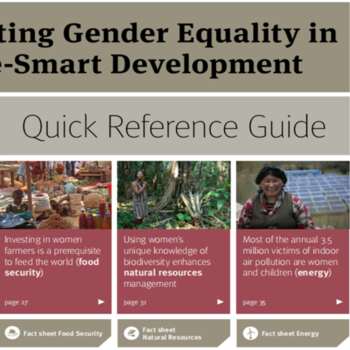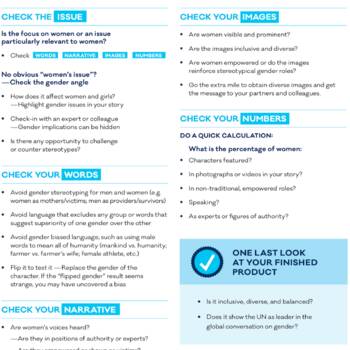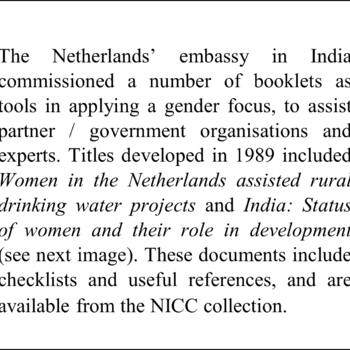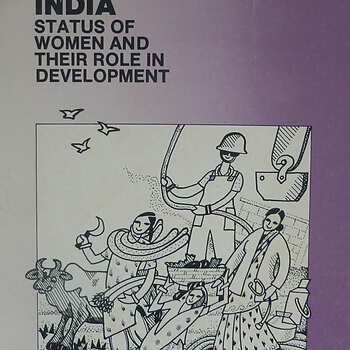The overview of gender tools and checklists presented below is not exhaustive. For more references also consult the NICC website, especially the collection of materials.
Experience learnt that gender equality and women’s empowerment are not automatically achieved by just including these as result areas. The ‘blind spot’ on women’s development and gender issues, despite women being about half of the population, requires adequate tools to make gender issues and women’s roles and needs visible and to design appropriate interventions, be it through gender mainstreaming or as gender stand-alone projects / programmes.
- Gender Analysis
Conducting a proper gender analysis is key to formulate and design effective gender policies and interventions. Gender analyses or gender assessments can be done at various stages of a project cycle, such as during context analyses or as part of a gender evaluation.
Annex 2 of the Quick Reference Guide on Integrating Gender Equality in Climate-Smart Development (NCEA 2014) explains the basics of a gender analysis.
i. What is a gender analysis?
Gender analysis is a tool for examining the differences between the roles that women and men play, the different levels of power they hold (including in decision-making), their differing needs, constraints and opportunities, and the impact of these differences on their lives. These differences can be examined at all levels (household, community, local and national levels). Gender analysis also looks into other diversity factors that affect all members of society, such as ethnicity, class or socio-economic conditions.
ii. Why conduct a gender analysis?
Conducting a gender analysis is important for one or more of the following reasons:
- To identify and address gender inequalities and understand their root causes
- To identify and eliminate barriers to women’s full participation in productive and public life (including decision-making)
- To identify potential gender impacts and prevent negative effects of interventions, i.e. increase of gender inequality (gender impact assessment, see item 2 below)
- To inform programming, project formulation and planning and provide a baseline to measure progress towards gender equality
iii. When to conduct a gender analysis?
Ideally, a gender analysis is conducted at the initial stage of designing a policy, programme or project, before developing strategies and interventions:
- As part of the context analyses, sector analyses, risk analyses and/or organization analyses that serve as input for the development of strategies and multi-annual strategic plans
- As part of the situational analysis in the phase of programme / project design
- If not done before the start of a programme / project: early in the implementation phase to use the outcomes to fine-tune the gender approach
- A gender analysis can also be done as part of a (gender) evaluation.
iv. Who conducts a gender analysis and how?
A gender analysis is conducted by an individual or team (internal or external) with gender expertise and experience as well as technical knowledge of the content of the programme. It also takes advantage of local expertise. Information from various sources is collected and analysed: desk research using existing gender reports or profiles, discussions with key persons, community / women’s groups, government officials and/or through surveys. A gender analysis can be a stand-alone activity and/or part of a broader situational or socio-economic analysis. To conduct a gender analysis often existing gender checklists are used, see item 3 below.
2. Gender impact assessment
A gender impact assessment (GIA) can be defined as the estimation of the different effects (positive, negative or neutral) of any policy, strategy, programme or project on the state of equality between men and women. It can be seen as an ex-ante gender evaluation that makes it possible to identify, in a preventative way, the likelihood of a given decision or project design having negative consequences for the state of equality between women and men. A gender impact assessment includes -or uses- a gender analysis of the current situation. It can only be conducted once first ideas or outlines of a policy, strategy, programme or project are known. Especially when the positive effects are likely to be nil or limited, it is good practice that a gender impact assessment provide recommendations for ‘mitigation measures’, i.e. measures that increase the positive impact on gender equality.
Examples of GIA tools:
- European Institute for Gender Equality, The EIGE Gender impact assessment guide
- Gender Impact Assessment – Implementation Tool – SWAP – Tool 4.1, 2015, developed by Thera van Osch. This tool aims to help policy makers to detect unintended negative effects of laws, policies, programmes, budgets and public services which may consolidate or increase gender gaps.
3. Gender Checklists and Guidelines
This section presents a selection of gender checklists, explaining several in more detail.
The Harvard Analytical Framework, published in 1985. This is one of the first frameworks designed for gender analysis. It has four components:
- Tool 1: The activity profile. This identifies all relevant productive and reproductive tasks to answer the question ‘who does what?’, i.e. women/girls and/or men/boys.
- Tool 2: The access and control profile. This indicates whether women or men have access to resources, who controls their uses, and who controls their benefits.
- Tool 3: Influencing factors. This aims to chart factors which influence the differences in the gender division of labour, access, and control as listed in the two above profiles (Tools 1 and 2).
- Tool 4: Checklist for project cycle analysis. These questions are designed to examine a project proposal or an area of intervention from a gender perspective.
Oxfam’s Guide to Gender-Analysis Frameworks of 1999 includes a good presentation of the above Harvard Analytical Framework and the following Gender Analysis Framework of Moser.
The Moser Gender Analysis Framework. This was developed by Caroline Moser in the 1980s; references are usually made to her book Gender Planning and Development: Theory, Practice and Training, Routledge, London, 1993. The framework rests on three basic concepts: the triple role of women, practical and strategic gender needs and categories of WID/GAD policy approaches. The Framework provides six tools:
- Tool 1 identifies gender roles: what women, men, boys and girls do in various productive, reproductive and community-managing activities.
- Tool 2 identifies the practical and strategic needs of women. Practical needs are ones that, if met, help women in current activities. Strategic needsare needs that, if met, transform the balance of power between men and women.
- Tool 3 defines an access and control profilefor resources and benefits of economic activity.
- Tool 4 examines the impact that a new policy, project or program will have on the three roles. A change addressing one area may affect others in a positive or negative sense.
- Tool 5 looks at how welfare, equity, anti-poverty, efficiency or empowerment approaches will address practical or strategic needs. The approaches are not mutually exclusive.
- Tool 6 looks at ways in which women and gender-aware organisations and individuals can be involved in the process.
The DAC/WID criteria were introduced in 1989 by the Development Assistance Committee (DAC) of OECD. Also within Dutch development cooperation the use of these criteria was promoted, e.g. as demonstrated in a memo of 1993 (only hard copy available). It became a main checklist used by MFA at that time. These criteria were:
- Women must be consulted in the design of the project, preferably through direct consultation of women of the target group.
- Women from the target group must be active participants during the implementation of the project.
- Constraints to female participation in the project must be identified and conditions (including financial) must be created to enhance women’s autonomy.
- Women & Development expertise must be planned, budgeted and utilised during the project cycle to ensure the full participation of women.
Other examples of relevant tools:
- Commissioned by MFA: Lingen, AC., Brouwers, R., de Klerk - Nugteren, M., & Plantenga, D. (1998). Gender Assessment Studies: A Manual for Gender Consultants, based on: Gender Assessment Study: a guide for policy staff, by Annet Lingen of ISS, 1994. The book is available at the KB national library in The Hague (not online).
- CIDA/Canada, Gender Based Analysis Plus
- Specific checklists were developed to assess gender specific impacts of also the Covid-19 pandemic, such as the following checklist by UN Women: the COVID-19, gender, and disability checklist: Preventing and addressing gender-based violence against women, girls, and gender non-conforming persons with disabilities during the COVID-19 pandemic.
4. Gender audit
A gender audit is a tool to assess and check the institutionalisation of gender equality into organisations, including in their policies, programmes and projects. Gender audits help organisations identify and understand gender patterns within their composition, structures, processes, budgets, organisational culture and management of human resources, and in the design and delivery of policies and services. They also help assess the impact of organisational performance and its management on gender equality within the organisation. Gender audits establish a baseline against which progress can be measured over time, identifying critical gender gaps and challenges, and making recommendations of how they can be addressed through improvements and innovations.
A gender audit typically covers gender equality (including diversion) within the organisation’s policies, objectives, implementation, selection criteria, monitoring, human resources (HR), budget, organizational culture and public image, as well as the availability of gender expertise, staff capacities, and the commitment of top management.
Examples:
- The EIGE guideline on doing a Gender Audit (2019) concisely describes what a gender audit is, the steps to be taken and the key questions. The steps include the drafting of a gender action plan and the creation of a gender committee to improve gender equality in the organisation and its work.
- UN Women and the United Nations Global Compact developed the Women’s Empowerment Principles Gender Gap Analysis Tool(WEPs Tool), which is a practical tool for organisations to make an audit of their gender gaps, to assess their commitment to advancing gender equality, and review the opportunities for improvement.
- A very comprehensive and widely used tool is the ILO manual for gender audit facilitators, updated in 2012.
5. Gender Mainstreaming Tools
Gender mainstreaming is the process of promoting gender equality perspectives in all policies, programmes and projects, at all levels and stages. It systematically recognizes and addresses gender issues in all sectors and thematic areas of international development, such as food security, education, health, or water. Gender mainstreaming thus aims to achieve that all policies, programmes and projects also contribute to increased gender equality.
The OECD-DAC Gender Equality Policy Marker (see for more information on this tool below under 6) includes minimum requirements for projects and programmes in which gender equality is a significant objective, i.e. in which gender is integrated. This means that proper mainstreaming should meet these requirements:
- A gender analysis of the project/programme has been conducted
- Findings from this gender analysis have informed the design of the project/programme
- Presence of at least one explicit gender equality objective backed by at least one gender specific indicator
- Data and indicators are disaggregated by sex where applicable
- Commitment to monitor and report on the gender equality results achieved by the project in the evaluation phase.
Other examples of guides and toolkits for gender mainstreaming are:
- Quick Reference Guide for Integrating Gender Equality in Climate-Smart Development, prepared by the Netherlands Commission on Environmental Assessments (NCEA) for the Netherlands Ministry of Foreign Affairs (MFA) in 2014. This document presents the policy cycle of MFA, providing entry points, opportunities, tips and best practices for integrating gender into each phase. An appendix contains a wealth of relevant gender resources.
- The Council of Europe, Gender Mainstreaming Toolkit for Co-operation Projects
- Government of Canada (CIDA), Feminist International Assistance Gender Equality Toolkit for Projects and Gender Equality
- Sweden (SIDA), Gender Toolbox and its briefs on gender analysis, gender equality in humanitarian assistance, women, water, sanitation and hygiene, women and land rights, women and food security, women’s organisations and the engagement of men and gender equality and gender equity, and the Handbook of Sweden’s feminist foreign policy
- UN Development Group, Resource Book for Mainstreaming Gender in UN Common Programming at the Country Level, 2018. This resource book supports the prioritization and mainstreaming of gender equality issues in UN programming at country level, in the context of the 2030 Agenda for sustainable development (the SDGs).
- Oxfam Gender Mainstreaming Tools (2002): Questions and checklists to use across the programme management cycle.
- Effective gender mainstreaming in water management for sustainable livelihoods: From guidelines to practice. Both ENDS Working Paper Series December 2006.
- The Toolkit on Mainstreaming Gender Equality in EC Development Cooperation (2004 and updated in 2007 and 2009) has been broadly used. In 2015 this EC Toolkit was replaced by the Resource Package for gender mainstreaming in EU Development Cooperation.
- In 2021 the EU has updated its 2014 Toolbox on the rights based approach (RBA) in line with its commitments to the SDGs and to reducing all forms of inequalities, including gender inequality: Human Rights Based Approach Toolbox
- An example of gender mainstreaming guidelines developed for a specific country: Gender Mainstreaming Guidelines in National Policy Formulation and Implementation (2004): This guide outlines the policy and administrative basis for Vietnam’s gender equality efforts and discusses the country’s gender mainstreaming policies. It was developed by the National Committee for the Advancement of Women in Viet Nam (CFAW) with support from the United Nations Development Programme (UNDP) and the Royal Netherlands Embassy.
6. DAC Gender Equality Policy Marker
The OECD-DAC gender equality policy marker is a tool to track aid in support of gender equality and women’s empowerment. DAC members, including the Netherlands, annually report their aid to the OECD Development Assistance Committee (DAC). They are required to indicate for each programme/project whether it targets gender equality as a policy objective according to a three-point scoring system. Projects/programmes marked as significant and principal (score 1 and 2) are counted as ‘gender equality focused aid’ by DAC, see example of 2019 annual reporting on this. This report shows that in 2019 62% of the Dutch aid targeted gender equality, which is well above the average of all OECD countries (38%), but less than some other countries as Sweden, Ireland, Iceland and Canada.
The scoring system is as follows:
- Score 0 (or G0) means ‘not targeted’: The project/programme has been screened against the gender marker but has not been found to target gender equality. Note that also for G0 projects and programmes a ‘do no harm’ approach is necessary to ensure that the project/programme does not perpetuate or exacerbate gender inequalities.
- Score 1 (or G1) means ‘significant’: Gender equality is an important and deliberate objective, but not the principle reason for undertaking the project/programme. This concerns projects/programmes in which gender is integrated or mainstreamed. The minimum requirements are listed above under gender mainstreaming tools.
- Score 2 (or G2) means ‘principal’: Gender equality is the main objective of the project/programme and is fundamental in its design and expected results. The project/programme would not have been undertaken without this gender equality objective.
In 2016 new minimum criteria were introduced for the gender markers, see here.
DAC recommends that donors adopt a twin-track approach to gender equality across their development cooperation portfolio, i.e. a combination of G1 and G2 projects/programmes. A principal score (G2) is not by definition better than a significant score (G1).
In the Dutch Ministry of Foreign Affairs’ administration system ‘Piramide’, the DAC gender marker is represented by the acronym ‘GlkhMV’ (gelijkheid tussen mannen en vrouwen), which translates as ‘equality between men and women’. Based on the EU gender action plan 2020-2025, 85% of all new actions should contribute to gender equality and women’s empowerment, i.e. score as G1 or G2. As a EU member state, also the Dutch MFA is expected to achieve this target.
7. Gender budgeting tools
Gender (responsive) budgeting is about gender mainstreaming in the budgetary process. It brings a gender equality perspective in each phase of the budget cycle (budget formulation, enactment, implementation and evaluation/audit) by addressing the priorities and needs of both women and men of all ages and in all their diversity, aiming at equal benefits for all.
Gender responsive budgeting is a powerful strategy that uses several tools to achieve equality between women and men by focusing on how public resources are collected and spent. It analyses central and local administrative budgets to assess gender funding gaps, to identify actions to close them and ensure that national and local commitments to gender equality and women’s empowerment are adequately funded.
The purpose of Gender Budgeting is threefold:
- to promote accountability and transparency in fiscal planning
- to increase gender responsive participation in the budget process, for example by undertaking steps to involve women and men equally in budget preparation
- to advance gender equality and women’s rights.
Gender budget analyses started in 1995, when the MFA requested the support of Prof. Diana Elson from the University of Manchester to design gender guidelines for economic policies in international cooperation. This resulted in three economic country profiles with a gender dimension for Nicaragua, Uganda and Pakistan. These gender economic profiles included a gender budget analysis. The WID-sector specialist of the Embassy of the Netherlands for Central America cooperated with the gender economic profile for Nicaragua, and extended the programme to the other Central American countries: Costa Rica, El Salvador, Guatemala and Honduras, which resulted in the publication Crecer con la Mujer; Oportunidades para el Desarrollo Económico Centroamericano (Growing with Women; Opportunities for Economic Development in Central America), published in 1997 by the Embassy of the Netherlands and the University of Manchester.
Relevant tools and guidance can be found in:
- Gender Budgets Make Cents: Understanding Gender Responsive Budgets by Debbie Budlender, Diane Elson, Guy Hewitt and Tanni Mukhopadhyay (2002)
- Budgeting for Women’s Rights: Monitoring Government Budgets for Compliance with CEDAW: A Summary Guide for Policy Makers, Gender Equality and Human Rights Advocates, by Diane Elson (2006)
- Public Expenditure Analysis. Public Sector Governance and Accountability. Washington, DC: World Bank. By Anwar Shah, 2005. Chapter 5 of this document is on Gender in Public Expenditure Reviews, and contains a section on Examples of Gender-Sensitive Budgetary Analysis.
- Oxfam, 2018: A guide to gender responsive budgeting
8. Gender Factsheets and Sector Papers
Factsheets provide useful information and definitions on the issue at stake, as well as references to relevant activities, often developed for a specific sector or geographic area. Sector papers focus on gender issues within a specific sector
- In 1989 MFA developed four Sector Papers on Women and Development, presenting main points and checklist. These were for the following sectors: Women and Agriculture; Women and Water and Sanitation; Women and Health; and Women and Energy, Forestry and Environment (only hard copies available).
- The Gender Resource Facility (a consortium of KIT and Femconsult) developed in 2017 five gender factsheets with corresponding memos, on the request of MFA. The topics of these factsheets are Finance, Climate Change, Food Security, Water and SRHR.
- The Quick Reference Guide for Integrating Gender Equality in Climate-Smart Development (2014) includes factsheets with information, recommendations and best practices for integrating gender in five MFA priority themes. These factsheets address the linkages between climate change and gender issues within Water, Food Security, Natural Resources, Energy and Disaster Risk Reduction sectors.
- The Council of Europe produced 12 concise factsheets (most recent in 2020) on its key areas of activity to promote gender equality. These cover topics such as equality between women and men, combating gender stereotyping, equal access to justice, and balanced participation of women and men in political and public decision-making. This information especially relates to the 47 member states of the Council of Europe.
- IUCN’s Gender and the Environment Resource Centre has recent factsheets on gender and the environment.
- The Gender and Water Alliance (GWA) has factsheets on gender, sanitation and climate change.
9. Gender Manuals and online Training Modules / Courses
UN Women defines gender-equality training as a ‘tool, strategy, and means to effect individual and collective transformation towards gender equality through consciousness raising, empowering learning, knowledge building, and skill development'. Gender-equality training is not a goal in itself, or a single tool to implement gender mainstreaming. It is part of the wider set of tools, instruments and strategies. Gender-equality training should be incorporated into a continuous and long-term process.
Over the years a wealth of gender training materials have been developed, including online training courses:
- OXFAM Gender training manual, 1994, Oxfam UK and Ireland
- EIGE Step by step guide to Gender Equality Training: These guiding principles present the minimum standards that needed to design effective skills development interventions for gender equality competence.
- Instituto per gli Studi di Politica Internazionale (ISPI). Syllabus Gender and Development, Master in Development, Course 2017, Thera van Osch.
- An example of an online gender course is one on Gender and Integrated Water Resources Management developed by Cap-Net, launched early 2022.
Use of tools and checklists by MFA
In their 2021 report on the status of gender mainstreaming, MFA’s Policy and Operations Evaluation Department (IOB) observed that gender analyses are conducted to an increasing degree. The quality of these analyses was variable and attention for women’s rights and gender equality did not necessarily translate into gender mainstreaming strategies and/or gender equality objectives.
The Ministry’s Task Force on Women’s rights and Gender equality (TFVG), established in 2014, offers advice to DGIS staff on how to conduct a gender analysis. However, the IOB found that TFVG neither systematically monitored the quality of these gender analyses nor reviewed what happened as follow-up to the findings of these analyses. Gender focal points indicated that a better understanding is needed of how gender analysis influences the subsequent stages of the policy cycle, including evaluation design.
The IOB recommended that the TFVG offer training, tools and best practices for conducting gender analyses. It should also be better ensured that results of gender analyses translate into strategies, activities and resources.
Thus the significance of the use of gender guidelines and checklists cannot be under-estimated. Tools and guidelines help experts, governmental and civil society staff to become aware and better understand and utilise gender knowledge to help create a better world with equality and peace for all.
Footnotes
[1] Within the Netherlands Ministry of Foreign Affairs, the Directorate General for International Cooperation (DGIS) is responsible for development cooperation policy and for its coordination, implementation and funding.



